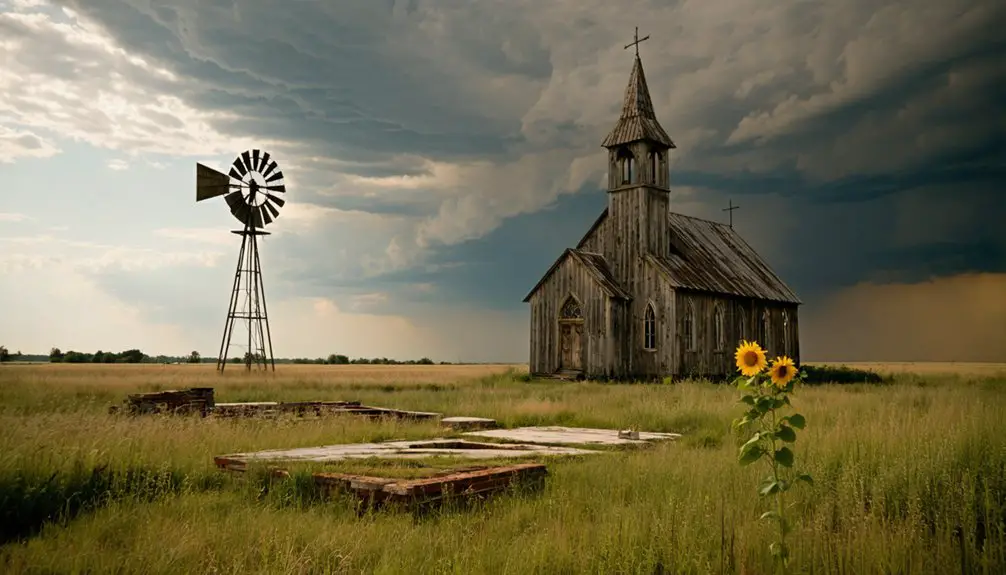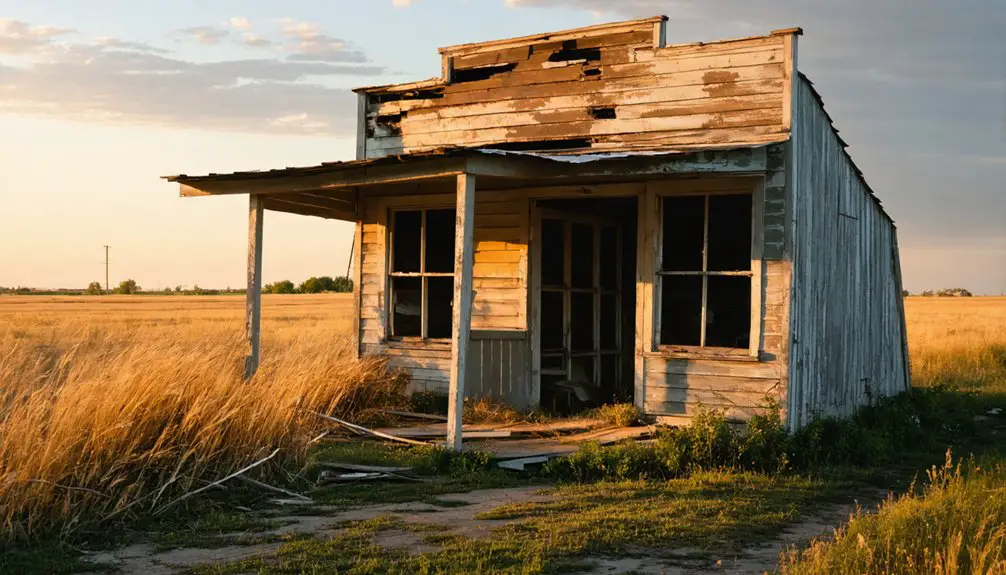You’ll find Hopewell in Pratt County‘s Rattlesnake Creek valley, where a vibrant prairie community once thrived in the early 1900s. The town’s story follows a familiar Kansas pattern: establishment around a post office in 1904, peak prosperity in the 1920s with a bank and bustling businesses, then decline during the Great Depression. Today, you can visit the historic crossroads at NW 140th Avenue and NW 110th Street, where the cemetery and scattered remnants whisper tales of prairie life.
Key Takeaways
- Hopewell became a ghost town after its post office permanently closed in 1973, marking the end of official community status.
- Located in Pratt County at NW 140th Avenue and NW 110th Street, with main remnants including Hopewell Cemetery and former business buildings.
- The town peaked in the 1920s but declined due to the Great Depression and closure of Farmers’ State Bank.
- Originally established in 1904, Hopewell thrived as a railroad town with essential businesses and community gathering places.
- The open prairie has reclaimed most of the settlement, though the site remains accessible for ghost town tourism.
From Post Office to Ghost Town: A Brief Timeline
The story of Hopewell, Kansas begins with the establishment of its post office in 1904, marking the town’s official recognition as a community.
You’ll find that the town’s early years were marked by fluctuating postal service, with the first closure occurring in 1908. When postal operations resumed in 1916, they did so under the name “Fravel” before returning to “Hopewell” in 1921.
During the 1920s, you’d have seen Hopewell at its peak, with the post office serving as a community hub alongside the Farmers’ State Bank, general store, and other businesses. The grain elevators towered over the town as a symbol of its agricultural prosperity. The locals often gathered for community rabbit hunts, competing for prizes and selling their catches.
But the town’s liveliness gradually faded, and by 1973, when the post office closed permanently, Hopewell had begun its shift to ghost town status, with mail service redirecting to nearby Macksville.
Economic Rise and Fall of a Prairie Settlement
While small prairie settlements often struggled to establish lasting economic foundations, Hopewell’s initial growth showed promising signs after its 1904 founding. You’d find the railroad’s arrival brought essential businesses – grain elevators, blacksmith shops, and a lumberyard. The Farmer’s State Bank, established in 1921, became the town’s economic anchor. Today, only historic headstones remain as silent witnesses to the community’s past.
Like many communities during the Great Depression era, Hopewell witnessed the exodus of farming families who could no longer maintain their operations. But Hopewell’s economic resilience faced mounting challenges. Despite creative ventures like profitable jackrabbit hunting (at 75 cents per rabbit), the town couldn’t diversify beyond agriculture.
As farming mechanization reduced labor needs, rural migration to cities diminished the local customer base. When the bank closed in the mid-1920s, followed by the post office’s shuttering, Hopewell’s fate was sealed.
The railroad that once promised prosperity couldn’t prevent the town’s decline into a ghost town.
Life in Early 20th Century Hopewell
Beyond its economic ups and downs, daily life in early 20th century Hopewell centered around a tight-knit network of community institutions.
You’d find farmers gathering at the grain elevators, while their wives shopped at the general store for household essentials. Children attended the one-room schoolhouse, where rural education meant sharing desks with kids of different ages and learning from a single teacher.
In rural towns, grain elevators and general stores buzzed with activity while children learned together in humble one-room schoolhouses.
The church and school hosted community gatherings throughout the year, bringing families together for social events and civic meetings.
You could catch up on local news at the post office, get your horse shod at the blacksmith’s shop, or grab supplies at the hardware store. Life moved with the farming seasons, and these local institutions kept Hopewell’s residents connected despite the challenges of prairie living. The area’s rich history stretched back centuries to when Kansas City Hopewell communities thrived there from 200 BC to 400 AD. These early inhabitants were known for their intricate copper crafts and extensive trade networks spanning across North America.
Physical Remnants and Location Today
Located in Pratt County’s Rattlesnake Creek valley, modern-day Hopewell stands as a quiet tribute to its former existence at the intersection of NW 140th Avenue and NW 110th Street. This historic location can be found using UTM coordinates 14S in modern mapping systems. For accuracy in navigation, users should verify all links when researching the site’s exact location.
At an elevation of 2,044 feet, you’ll find scattered architectural remains of what was once a bustling rural community.
The most significant physical remnants you can explore today include:
- The well-preserved Hopewell Cemetery just west of the original townsite
- Several surviving buildings that once housed the Farmers’ State Bank and other businesses
- The historic crossroads where the town’s commercial district thrived
While most structures have succumbed to time, the cemetery’s significance endures as a symbol of the community’s legacy.
The surrounding farmland and open prairie have reclaimed much of what was once a hopeful Kansas settlement.
Legacy of a Lost Kansas Community

Although Hopewell’s physical structures have largely vanished, the town’s legacy endures through rich oral histories and the determined spirit of its former residents.
You’ll find the town’s story preserved in tales of community identity, from the lively rabbit hunts between local lodges to the warm gatherings at Roy and Mina Hodson’s home where church quartets would sing.
The town’s journey mirrors countless other rural Kansas communities, where strong social bonds flourished despite economic challenges.
While Hopewell couldn’t survive the harsh realities of changing times, its memory lives on through ghost town studies and tourism.
You can still trace its influence in local placenames, particularly the cemetery, which stands as a monument to the rural nostalgia and pioneering spirit that once defined this close-knit farming community.
Frequently Asked Questions
What Was the Population of Hopewell During Its Peak Years?
While exact Hopewell demographics aren’t recorded, ghost town history indicates you’re looking at a peak population under 500 residents, with most estimates suggesting just a few hundred at its busiest period.
Were There Any Notable Crimes or Incidents in Hopewell’s History?
Like a clean slate in history’s pages, you won’t find mysterious disappearances or unsolved crimes here. Records show Hopewell’s decline was purely economic, with the bank’s closure being the town’s main downfall.
What Natural Disasters, if Any, Affected the Town of Hopewell?
You won’t find records of specific tornado impact or flood damage affecting this town. While Kansas faced many natural disasters, historical documents don’t mention any directly impacting Hopewell’s development or decline.
How Many Students Typically Attended the Hopewell School?
You’ll find that 10-30 students typically attended this one-room schoolhouse, reflecting common rural school attendance patterns. The student demographics shifted seasonally as farm families balanced education with agricultural demands.
What Happened to the Residents When They Left Hopewell?
You’ll find most former residents sought life after Hopewell in nearby towns like Macksville and Pratt, where they’d find better jobs, banking services, and integrated into these stronger communities through relocation.
References
- https://legendsofkansas.com/hopewell-kansas/
- http://kansasghosttowns.blogspot.com/2011/05/hopewell-kansas-pratt-county-ghost-town.html
- https://www.youtube.com/watch?v=x0G1GMLRrF8
- https://wikipedia.nucleos.com/viewer/wikipedia_en_all/A/Hopewell
- https://www.youtube.com/watch?v=PfThSLZOtqg
- https://about.usps.com/who/profile/history/pdf/first-rfd-kansas.pdf
- https://www.archives.gov/research/post-offices/locations-1837-1950.html
- https://en.wikipedia.org/wiki/Hopewell
- https://www.legendsofamerica.com/gt-emergingghosttowns/
- https://www.youtube.com/watch?v=alC1wDdSVvg



